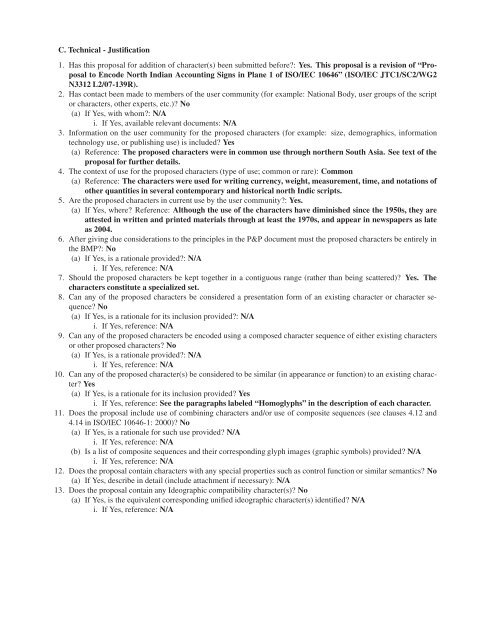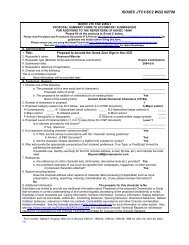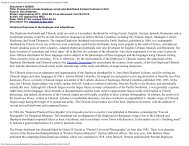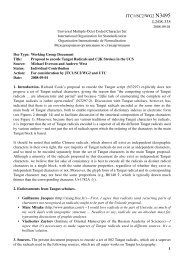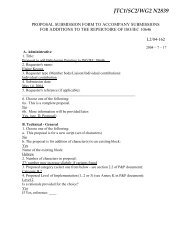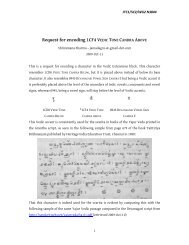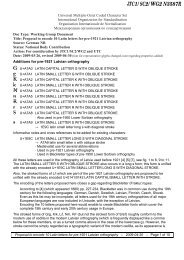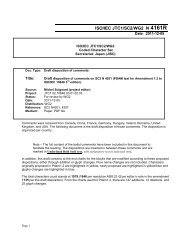Common Indic Number Forms - dkuug
Common Indic Number Forms - dkuug
Common Indic Number Forms - dkuug
Create successful ePaper yourself
Turn your PDF publications into a flip-book with our unique Google optimized e-Paper software.
C. Technical - Justification<br />
1. Has this proposal for addition of character(s) been submitted before?: Yes. This proposal is a revision of “Proposal<br />
to Encode North Indian Accounting Signs in Plane 1 of ISO/IEC 10646” (ISO/IEC JTC1/SC2/WG2<br />
N3312 L2/07-139R).<br />
2. Has contact been made to members of the user community (for example: National Body, user groups of the script<br />
or characters, other experts, etc.)? No<br />
(a) If Yes, with whom?: N/A<br />
i. If Yes, available relevant documents: N/A<br />
3. Information on the user community for the proposed characters (for example: size, demographics, information<br />
technology use, or publishing use) is included? Yes<br />
(a) Reference: The proposed characters were in common use through northern South Asia. See text of the<br />
proposal for further details.<br />
4. The context of use for the proposed characters (type of use; common or rare): <strong>Common</strong><br />
(a) Reference: The characters were used for writing currency, weight, measurement, time, and notations of<br />
other quantities in several contemporary and historical north <strong>Indic</strong> scripts.<br />
5. Are the proposed characters in current use by the user community?: Yes.<br />
(a) If Yes, where? Reference: Although the use of the characters have diminished since the 1950s, they are<br />
attested in written and printed materials through at least the 1970s, and appear in newspapers as late<br />
as 2004.<br />
6. After giving due considerations to the principles in the P&P document must the proposed characters be entirely in<br />
the BMP?: No<br />
(a) If Yes, is a rationale provided?: N/A<br />
i. If Yes, reference: N/A<br />
7. Should the proposed characters be kept together in a contiguous range (rather than being scattered)? Yes. The<br />
characters constitute a specialized set.<br />
8. Can any of the proposed characters be considered a presentation form of an existing character or character sequence?<br />
No<br />
(a) If Yes, is a rationale for its inclusion provided?: N/A<br />
i. If Yes, reference: N/A<br />
9. Can any of the proposed characters be encoded using a composed character sequence of either existing characters<br />
or other proposed characters? No<br />
(a) If Yes, is a rationale provided?: N/A<br />
i. If Yes, reference: N/A<br />
10. Can any of the proposed character(s) be considered to be similar (in appearance or function) to an existing character?<br />
Yes<br />
(a) If Yes, is a rationale for its inclusion provided? Yes<br />
i. If Yes, reference: See the paragraphs labeled “Homoglyphs” in the description of each character.<br />
11. Does the proposal include use of combining characters and/or use of composite sequences (see clauses 4.12 and<br />
4.14 in ISO/IEC 10646-1: 2000)? No<br />
(a) If Yes, is a rationale for such use provided? N/A<br />
i. If Yes, reference: N/A<br />
(b) Is a list of composite sequences and their corresponding glyph images (graphic symbols) provided? N/A<br />
i. If Yes, reference: N/A<br />
12. Does the proposal contain characters with any special properties such as control function or similar semantics? No<br />
(a) If Yes, describe in detail (include attachment if necessary): N/A<br />
13. Does the proposal contain any Ideographic compatibility character(s)? No<br />
(a) If Yes, is the equivalent corresponding unified ideographic character(s) identified? N/A<br />
i. If Yes, reference: N/A


